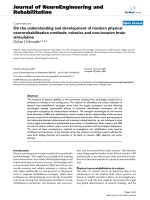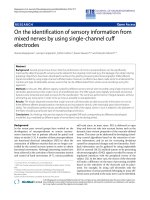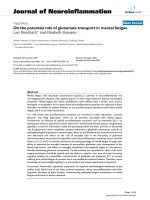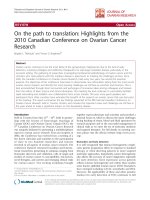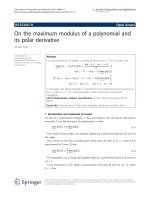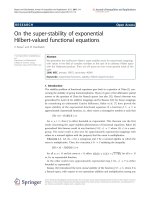báo cáo hóa học: " On the solvability conditions of the first boundary value problem for a system of elliptic equations that strongly degenerate at a point" pdf
Bạn đang xem bản rút gọn của tài liệu. Xem và tải ngay bản đầy đủ của tài liệu tại đây (361.16 KB, 11 trang )
RESEARC H Open Access
On the solvability conditions of the first
boundary value problem for a system of elliptic
equations that strongly degenerate at a point
Stasys Rutkauskas
Correspondence: stasys.
Institute of Mathematics and
Informatics of Vilnius University,
Akademijos str. 4, LT-08863, Vilnius,
Lithuania
Abstract
A system of elliptic equations which are irregularly degenerate at an inner point is
considered in this article. The equations are weakly coupled by a matrix that has
multiple zero eigenvalue and corresponding to it adjoint vectors. Two statements of
a well-posed Dirichlet type problem in the class of smooth functions are given and
sufficient conditions on the existence and uniqueness of the solutions are obtained.
Keywords: systems of elliptic equations, degenerate elliptic equations, boundary
value problems, Dirichlet type problem
1 Introduction and statement of the problems
The first results in the area of boundary value problems for an elliptic equation with
degeneracy at an inner point of the considereddomainareobtainedin[1].Inthat
study, the Dirichlet problem for a weakly (regularly) degenerating elliptic equation with
the main part of Laplace’s operator is studied. These results are developed in [2],
where the degenerate elliptic operator is generalized and, over and above, the second
boun dary value problem is investigated. In [3], the existence of a weak solution to the
Dirichlet problem for an elliptic equation degenerating at isolated points in the class of
Hölder functions is proved. In the case of the strong (irregular) degeneracy, can new
effects emerge which influence the well-posedness of the boundary value problems.
For instance, in [4], it is shown that in a well-posed Dirichlet type problem the asymp-
totic of the solution near the degeneracy point is supposed to be known. Many more
difficulties come into being in the investigation of the systems of degenerate elliptic
equations. Some results for weakly related degenerate elliptic systems are obtained i n
[5-7]. Particularly, these articles deal with Dirichlet type problems for the elliptic
system
a(r)u +
n
i
=1
B
i
(x)u
x
i
+ C(x)u =0, x ∈ D
,
(1)
where r =|x|, a is a continuous function such that a(r)=o(1) as r ® 0, and a(r)>0
for r >0,x = 0 is an inner point of domain D, Δ is Laplace’s operator, B
i
(x)andC(x)
are diagonal and square matrices, consequently, which are smooth enough in
D
. In [5,6],
the Dirichlet problem in the class of vect or functions u bounded in D
0
= D\{x =0}is
Rutkauskas Boundary Value Problems 2011, 2011:16
/>© 2011 Rutkauskas; licensee S pringer. This is an O pen Access article distributed under the terms of the Creative Commons Attribution
License ( which permits unrestricted use, distribution, and reproduction in any medium,
provided the original work is properly cited.
solv ed under the assumption that elements of the matrices B
i
(x) tend to zero, as x ® 0,
fastenough.In[7],aweightedDirichletproblem with supplementa ry weighted condi-
tion of the shape
lim
x→0
(x)u(x) − h
x
r
=0
(2)
is considered under the condition a(r)=O(r
2a
), a >1, as r ® 0.Inthesamestudy,Ψ
(x) is some matrix entries of which are decreasing as x ® 0, and h is a given vector func-
tion smooth on th e unit sphere. It is noteworthy that the matrix C(x)isassumedtobe
negatively definite in D, i.e., it does not have any zero eigenvalue. Moreover, C(0) should
be a normal matrix for the weighted Dirichlet problem to be well-posed. (If coefficients
B
i
(x) have the main influence to the asympto tic of the solutions of system (1), then the
last requirement is dispensable [8,9]). Therefore, it is important to consider the case
where C(0) has multiple zero eigenvalue and corresponding to it adjoint vectors.
Hence, the present article deals with a particular case of system (1) of the shape
u − q
(
r
)
u =
0
(3)
in the ball ∑
R
={x :|x|<R}⊂ R
3
with the Dirichlet condition
u
|
S
R
= f
.
(4)
In this article, Λ is a real constant non-negative definite N × N matrix having the
eigenvalue l =0,q is scalar continuous function positive for r ≠ 0 and such that
q
(
r
)
= O
(
r
−2α
)
, α>1, as r → 0
,
(5)
S
R
= ∂∑
R
, f =(f
1
, f
2
, ,f
N
} and u =(u
1
, u
2
, , u
N
) are the given and unknown vector
functions, respectively. (Condition (5) means with respect to system (1) that a(r)
vanishes as r ® 0 not faster than a ny power of r.) Hence, the order of sy stem (3) is
strongly degenerate at the point x = 0 because of a >1.
Let S be a non-degenerate matrix such that
SS
−1
= J
=diag
L
m
0
(λ
0
)L
m
1
(λ
1
) L
m
p
(λ
p
)
is the canonical Jordan form of Λ with m
i
× m
i
lower blocks
L
m
i
(λ
i
)=
⎛
⎜
⎜
⎜
⎜
⎝
λ
i
0 00
1 λ
i
00
··· ··· ··· ··· ···
00 λ
i
0
00 1 λ
i
⎞
⎟
⎟
⎟
⎟
⎠
, i =
0, p
.
Multiplying both (3) and (4) from the left by S, we get the system
v − q
(
r
)
J
v =
0
(6)
and the Dirichlet condition
v
|
S
R
= g
,
(7)
where v = Su,andg = Sf. Therefore, system (6) and Dirichlet condition (7) can be
split into p + 1 separate systems
v
i
− q(r)L
m
i
(λ
i
)v
i
=0
,
Rutkauskas Boundary Value Problems 2011, 2011:16
/>Page 2 of 11
and Dirichlet conditions
v
i
|
S
R
= g
i
, i = 0, p
,
which correspond to the blocks of Jordan matrix J
Λ
,wherebothv
i
and g
i
are m
i
-
dimensional vector functions. If Λ is a matrix of simple structure, then all m
i
=1,i.e.,
(6) splits into N separate equations, obviously.
Let l
0
= 0 and, for convenience, only one eigen vector corresponds to this eigen-
value of Λ.Then,Rel
i
<0fortherest
i = 1,
p
, since the matrix Λ is non-negatively
defined. As mentioned above, the solvability of a Dirichlet type problem under the
condition Re l
i
< 0 is investigated in [6,7].
The main aim of this article is to give a well-posedness of the Dirichlet type pro-
blems to the system
v
0
− q(r)L
m
0
(0)v
0
=0
,
(8)
which is in accordanc e with eigenvalue l
0
=0ofΛ. In o rder to avoid the compli-
cated notations, instead of (8), we consider the system
v − q
(
r
)
L
s
(
0
)
v =0
,
(9)
where v =(v
1
, v
2
, , v
s
)andL
s
(0) is a s × s lower Jordan block with zero diagonal
entries. It is easily seen that
v
1
=0,
v
k+1
= q(r)v
k
, k = 1, s − 1
,
is the outspread form of (9).
Denote
0
R
=
R
\{x =0
}
.Let||v|| be the Euclidian norm of a vector v.Wepropose
the two following statements of the Dirichlet type problem to system (9).
Problem D
1
.Findasolution
v =(v
1
, v
2
, , v
s
) ∈ C
2
(
0
R
) ∪ C
0
R
∪ S
R
of Equation
9 that satisfies Dirichlet condition
v
|
S
R
= g
,
(10)
and relation
r
v(x)
= o(1), as x →
0
(11)
Problem D
2
. Find a solution
v ∈ C
2
(
0
R
) ∪ C
0
R
∪ S
R
of Equation 9, such that it
satisfies Dirichlet condition (11) and is bounded in
0
R
.
2 The properties of particular solutions of Equation 8
Let
H
m
n
(x
)
be mth the harmonic of a homogeneous harmonic polynomial of degree n,
a
i.e.,
H
m
n
(λx)=λ
n
H
m
n
(x
)
and
H
m
n
(x)=0
.Then,
r
−n
H
m
n
(x)=H
m
n
(ω
)
(here ω = x /r)is
the mth spherical harmonic of order n continuous on the unit sphere S
1
.Letc
nm
be
any constant vector, and let Q
n
(r) be a matrix solution of ODEs system
l
n
(
w
)
− q
(
r
)
L
s
(
0
)
w =0, 0< r < R
,
(12)
where
l
n
=
d
2
dr
2
+
2(n +1)
r
d
dr
Rutkauskas Boundary Value Problems 2011, 2011:16
/>Page 3 of 11
and w is an unknown s-dimensional vector function. Then, the functions
v
nm
(x)=r
n
H
m
n
(ω) Q
n
(r)c
nm
, n =0,1,2, , m =0,±1, , ±n
,
(13)
represent the particular solutions of system (9).
We seek for a solution Q
n
(r) of system (12), which satisfies condition Q(R)=E,
where E is the unit matrix. To this end, on the set of functions ψ bounded on the
interval (0, R), we consider the integral operator
K
n
(ψ)(r)=
R
0
K
n
(r, t)q(t)ψ(t)dt ,
K
n
(r, t)=−
t
2n+2
2n +1
×
r
−2n−1
− R
−2n−1
,0< t ≤ r
,
t
−2n−1
− R
−2n−1
, r ≤ t ≤ R,
and its integer powers
K
σ
n
(ψ)(r)=K
n
K
σ −1
n
(ψ)
(r)
,
where by definition K
0
(ψ)(x) ≡ ψ (x). Obviously, according to this definition
K
σ
n
(ψ)(r)=−
1
2n +1
⎛
⎝
r
−2n−1
− R
−2n−1
r
0
t
2n+2
q(t)K
σ −1
n
(ψ)(t)dt
+
R
r
t
1 −
t
R
2n+1
q(t)K
σ −1
n
(ψ)(t)dt
⎞
⎠
, σ =1,2,
.
(14)
Lemma 1. Let relation (5) hold. If
n >σ(α − 1) −
1
2
, then
K
σ
n
(ψ)(r) ≤
M
σ
n
σ
r
2σ (1−α)
)on(0,R)
,
(15)
where M
s
is some constant independent of n, and
K
σ
n
(ψ)(R)=
0
(s = 1, 2, ).
Proof. We prove relation (15) by induction.
Since ψ (r) is bounded on (0, R), inequality (15) holds for s = 0 with some constant
M
0
. It follows from relation (5) that 0 <q(r) ≤ Mr
-2a
∀r Î (0, R), where M is a positive
constant. Then,
q
(
t
)
|ψ
(
t
)
|≤MM
0
t
−2
α
∀t Î (0, R) . Assuming that
n >α−
3
2
,we
obtain that
K
n
(ψ)(r)
≤
M
2n +1
⎛
⎝
r
−2n−1
r
0
t
2(n+1−α)
dt +
R
r
t
1−2α
dt
⎞
⎠
≤
M
2n +1
1
2n − 2α +3
+
1
2
(
α − 1
)
r
2(1−α)
,
i.e., the estimate
K
n
(ψ)(r)
≤
M
1
n
r
2(1−α
)
with some constant M
1
independent of n holds. Thus, the validity of (15) is proved
for s =1.
Rutkauskas Boundary Value Problems 2011, 2011:16
/>Page 4 of 11
Let (15) be valid for s = k -1 under the condition
n > (k − 1)(α − 1) −
1
2
. Then,
t
2n+2
q(t)
K
k−1
n
(ψ)(t)
≤
MM
k−1
n
k−1
t
2(n+k(1−α))
∀t ∈ (0, R)
,
i.e., the first integral in expression (14) converges, if
n
> k(α − 1) −
1
2
, and
K
k
n
(ψ)(r)
≤
MM
k−1
n
k−1
(
2n +1
)
⎛
⎝
r
−2n−1
r
0
t
2(n+k(1−α))
dt +
R
r
t
2k(1−α)−1
dt
⎞
⎠
≤
MM
k−1
n
k−1
(
2n +1
)
1
2n +2k
(
1 − α
)
+1
+
1
2k
(
α − 1
)
r
2k(1−α)
.
Therefore, there exists a constant M
k
such that (15) holds for s = k under the condi-
tion
n > k(α − 1) −
1
2
.
If
n >σ(α − 1) −
1
2
, then the first integral on the right-hand side of (14) converg es
as r Î (0, R), and, evidently,
K
σ
n
(ψ)(R)=
0
. ■
It is easy to verify that
l
n
K
σ
n
(ψ)
= q(r)K
σ −1
n
(ψ)(r), σ =1,2,
,
(16)
under the conditions of Lemma 1.
Note that w
1
≡ 1 and w
2
= r
-2n-1
are linearly independent solutions of the differential
equation l
n
(w) = 0. Thus, if w is the solution of this equation such that w(r)=o(r
-2n-1
)
as r ® 0, then w(r) ≡ const.
Denoting, as usual, by [a] the integer part of the real number a, we introduce the
integer
α
k
=
k(α − 1) +
1
2
, where k is a non-negative integer. (Note that a
0
= 0.)
We use below denotation
K
σ −1
n
(r)=K
σ −1
n
(ψ)(r
)
in the case ψ (x) ≡ 1.
Theorem 1. Let relation (5) hold. If n ≥ a
s-1
, then there exists a unique matrix solu-
tion Q
n
(r)={q
nij
(r)} of Equation 12 such that
q
ni
j
(r)=o(r
−2n−1
), as r → 0, i, j = 1, s
,
(17)
and
Q
n
(
R
)
= E
.
(18)
Proof. Let the condition n ≥ a
s-1
be valid. Then, according to Lemma 1, the functions
σ = 0
,
s − 1
,
σ = 0
,
s − 1
, are continuous on the interval (0, R). Introduce the s × s
matrix Q
n
(r)={q
nij
(r)} by the formula
q
nij
(r)=
0, if i < j,
K
i−j
n
(r), if i ≥ j
.
(19)
Note that estimate (15) yields the relations
q
nij
(r)=O
r
2(i−j)(1−α)
,as r → 0, 1 ≤ j ≤ i ≤ s
.
(20)
Rutkauskas Boundary Value Problems 2011, 2011:16
/>Page 5 of 11
This implies the validity of condition (17), because 2n+1 > 2( s -1)(a -1)≥ 2(i - j)(a -
1), for
i,
j
= 1, s
. Moreover,
l
n
(
Q
n
)
= q
(
r
)
L
s
(
0
)
Q
n
on
(
0, R
)
because of (16), i.e., Q
n
is the matrix solution of Equation 12. Evidently, equality (18)
follows from (14).
It remains to prove the uniqueness of the solution of problems (12), (17), and (18).
Let
˜
Q
n
(r)={
˜
q
ni
j
}
be a matrix solution of system (12) continuous on (0, R), and satisfy-
ing both conditions
˜
q
ni
j
(r)=o(r
−2n−1
)
,asr ® 0, and
˜
Q
n
(
R
)
=
,whereΘ is zero
matrix. Then, the equalities
l
n
(
˜
q
n1j
)=0,
l
n
(
˜
q
n,k+1,
j
)=q(r)
˜
q
nk
j
(r), k = 1, s − 1
,
on the interval (0, R)hold.Since
˜
q
n1
j
(r)=o(r
−2n−1
)
as r ® 0, we obtain that
˜
q
n1
j
(r)=cons
t
on the interval (0, R). Then, the condition
˜
q
n1
j
(R)=
0
yields the identity
˜
q
n1
j
(r) ≡
0
because of the continuity of the function
˜
q
n1
j
on (0, R). In such a case, the
elements of the second row of matrix
˜
Q
n
satisfy the equation
l
n
(
˜
q
n2
j
)=
0
. For the same
reason as a bove, we obtain that
˜
q
n2
j
(r) ≡ 0(j = 1, s
)
on (0, R). Further, continuing this
process, we get that
˜
q
n3
j
(r) ≡ 0, ,
˜
q
ns
j
(r) ≡ 0(j = 1, s
)
on (0, R). Hence,
˜
Q
n
(
r
)
≡
on
(0, R). This yields the uniqueness of the solution of problems (12), (17), and (18).
What is the structure of the solutions of system (12) that increase slower than r
-2n-1
in the case where n does not satisfy the condition n ≥ a
s-1
? In order to get the answer
to this question, we introduce s × s matrices
E
k
=
e
(k)
ij
(k = 1, s
)
with entries
e
(k)
ii
=
1
for s - k +1≤ i ≤ s, and
e
(k)
i
j
=
0
for all rest i and j. (Note that E
s
= E according to this
definition.) Let us compose the matrixes
Q
(k)
n
(
r
)
= Q
n
(
r
)
E
k
, k = 1, s
,
where Q
n
is matrix elements of which are giv en by (19). It is easily seen that
Q
(s)
n
(
r
)
= Q
n
(
r
)
E = Q
n
(
r
)
, and the elements
q
(k)
ni
j
(r
)
of rest matrixes
Q
(k)
n
(
r
)(
k = 1, s − 1
)
are defined by following formula
q
(k)
nij
(r)=
K
i−j
n
(r), if s − k +1≤ j ≤ i ≤ s,
0, if 1 ≤ j ≤ s − k and i > j.
If n ≥ a
k-1
, then the powers
K
i−j
n
(
r
)
exist for all i and j such that s - k +1≤ j ≤ i ≤ s,
and according to (20), the relation
q
(k)
ni
j
(r)=O(r
2(i−j)(1−α)
)=o(r
−2n−1
), as r →
0
(21)
holds. Moreover, we obtain by direct calculation that
l
n
(Q
(k)
n
)=q(r)L
s
(0)Q
(k)
n
on (0, R)
,
Q
(k)
n
(
R
)
= E
k
(22)
for
∀k = 1
,
s − 1
due to the definition of matrix
Q
(k)
n
. Hence, there holds the following
Rutkauskas Boundary Value Problems 2011, 2011:16
/>Page 6 of 11
Theorem 2. Let relation (5) hold, and let natural k,1≤ k ≤ s - 1, be such that a
k+1
≤
n a
k
. Then, there exists a unique matrix solution
Q
(k)
n
(r)=
q
(k)
nij
(r)
of Equation 12
such that relation (21) holds, and boundary value condition (22) is satisfied.
The uniqueness of the matrix solution
Q
(k)
n
can be proved in the same way as that of
the matrix solution Q
n
. In this case, condition (21) is essential, just similar to condition
(17) in Theorem 1.
Hence, we obtain to system (9) the following set of particular solutions (see (13)):
v
(k)
nm
=
r
R
n
H
m
n
(ω) Q
(k)
n
(r)c
nm
for n
k−1
≤ n <α
k
, k = 1, s − 1
,
v
(s)
nm
=
r
R
n
H
m
n
(ω) Q
n
(r)c
nm
for n ≥ α
s−1
,
where c
nm
is arbitrary constant column vector.
3 Existence and uniqueness of the solutions of problems D
1
and D
2
Let us compose the superposition
v =
s−1
k=1
α
k−1
≤n<α
k
r
R
n
Q
(k)
n
(r)
|
m
|
≤n
H
m
n
(ω) c
n
m
+
∞
n=α
s−1
r
R
n
Q
n
(r)
|
m
|
≤n
H
m
n
(ω) c
nm
(23)
of the particular solutions obtained above. Note, if
α
k
0
=0
for some k
0
,1≤ k
0
≤ s -1,
then a
k
=0forallnaturalk ≤ k
0
- 1. (Such a situation can come to exist, i f a <2.)
Therefore, all the sums
α
k
−1
≤n<α
k
in (23), in which the inequality a
k-1
<a
k
is impossi-
ble, are taken to be equal to zero.
Evidently, if the series (23) converges and its sum v is twice differentiable in the
spherical layer
δ
R
= {x : δ<|x| < R
}
with arbitrarily small δ, then this series satisfies
system (9) in the ball
0
R
. Note that
v|
S
R
=
s−
1
k=1
α
k−1
≤n<α
k
|
m
|
≤n
H
m
n
x
R
E
k
c
n
m
+
∞
n=α
s−1
|
m
|
≤n
H
m
n
x
R
c
nm
(24)
due to both (18) and (22).
Assume that the boundary vector function g =(g
1
, g
2
, ,g
s
) (see (10)) is twice differenti-
able on unit sphere S
1
. Thus, it can be expressed on the sphere S
R
by Laplace series [10]:
g(x)=
∞
n=0
|
m
|
≤n
H
m
n
(
ω
)
a
nm
, x ∈ S
R
,
(25)
which converge (component -wise) uniformly and absolutely according to the
assumed smoothness of the vector function g. The coefficients
a
nm
=
(
a
(1)
nm
, a
(2)
nm
, , a
(s)
nm
)
in (25) can be calculated as follows
b
:
a
(i)
nm
=
2n +1
4πR
2
(n − m)!
(n + m)!
S
R
h
i
(ϕ, ϑ )Y
m
n
(ϕ, ϑ )dϕdϑ,
|
m
|
≤
n
Rutkauskas Boundary Value Problems 2011, 2011:16
/>Page 7 of 11
where h
i
(, ϑ)=g
i
(x), for |x|=R and
Y
m
n
(ϕ, ϑ )=H
m
n
(
ω
)
, , ϑ (0 ≤ ≤ 2π,0≤ ϑ ≤
π) are spherical coordinates which are introduced by the rule: x
1
= r sin ϑcos , x
2
= r
sin ϑsin , and x
3
= r cos ϑ.
It is easily seen that series (24) coincid es with series (25), if c
nm
= a
nm
for n ≥ a
s -1
,
and E
k
c
nm
= a
nm
for a
k-1
≤ n <a
k
,
k = 1
,
s − 1
, i.e., if components h
1
, h
2
, , h
s-1
of vec-
tor function h satisfy the following orthogonality conditions
S
R
h
k
(ϕ, ϑ )Y
m
n
(ϕ, ϑ )dϕdϑ =0 for0≤ n <α
s−k
, k = 1, s − 1
,
(26)
on sphere S
R
. Let us consider series (23), in which c
nm
= a
nm
:
v =
s−1
k=1
α
k−1
≤n<α
k
r
R
n
Q
(k)
n
(r)
|
m
|
≤n
H
m
n
(ω) a
nm
+
∞
n=α
s−1
r
R
n
Q
n
(r)
|
m
|
≤n
H
m
n
(ω) a
nm
.
(27)
Assume that condition (26) is fulfilled in addition to the smoo thness of g.Then,
v
|
S
R
=
g
, i.e., series (27) converges (component-wise) uniformly and absolutely on the
sphere S
R
.
We shall prove that series (27) converge s uniformly a nd absolutely in the spherical
layer
δ
R
with arbitrarily small δ. Note that components v
i
(
i = 1, s
)
of the v ector func-
tion v =(v
1
, v
2
, , v
s
) in (27) can be formally represented in the form
v
1
= w
1
(
x
)
, v
k
= w
k
(
x
)
+ W
k
(
x
)
, k = 2, s
,
(28)
where
w
k
(x)=
∞
n=α
s−k
r
R
n
|
m
|
≤n
a
(k)
nm
H
m
n
(
ω
)
, k =
1, s
,
(29)
W
k
(x)=
k−1
l=1
∞
n=α
s−l
r
R
n
K
k−l
n
(r)
|
m
|
≤n
a
(l)
nm
H
m
n
(
ω
)
, k =
2, s
.
(30)
The terms
r
R
n
|
m
|
≤n
a
(k)
nm
H
m
n
(
ω
)
of the series on the right-hand side of (29) are harmonic functions in ∑
R
. Since these
series converge uniformly on the sphere S
R
, they also converge uniformly in ∑
R
,and
their sums w
k
(r, ω),
k = 1
,
s
, are harmonic functions in ∑
R
because of Harnack’stheo-
rem [11].
Further, according to Lemma 1 estimates
K
k−l
n
(r) ≤
M
k−l
n
k−l
r
2(k−l)(1−α)
, l = k − 1, s + k − 1,
hold, where n ≥ a
k-l
and M
k-l
is a constant independent of n. Consequently,
r
R
n
K
k−l
n
(r)
|
m
|
≤n
H
m
n
(
ω
)
a
(l)
nm
<
M
k−l
n
k−l
r
2(k−l)(1−α)
|
m
|
≤n
H
m
n
(
ω
)
a
(l)
nm
Rutkauskas Boundary Value Problems 2011, 2011:16
/>Page 8 of 11
in
δ
R
for ∀n ≥ a
k-l
. Note t hat the constants M
k
,
k = 1
,
s − 1
, do not depend o n n as
well as on δ. Evidently, they yield the uniform and absolute convergence of series (30)
in
δ
R
=
δ
R
∪ S
R
∪ S
δ
.
Let G
δ
(x, ξ) be the Green function of the Dirichlet problem to Laplace equation in
δ
R
,andletw
kn
(x)andW
kn
(x)bethenth partial sum of corresponding series (29) and
(30). Since
W
2n
(
x
)
≡ q
(
r
)
w
1n
(
x
),
in
0
R
, relations
W
2n
(x)=
δ
R
G
δ
(x, ξ )w
1n
(
ξ
)
dσ
ξ
,
W
kn
(x)=
δ
R
G
δ
(x, ξ )
w
(k−1)n
(
ξ
)
+ W
(k−1)n
(
ξ
)
dσ
ξ
, k = 3, s
,
hold, where ds
ξ
is a volume element of
δ
R
. These yield the equalities
∂
2
W
2n
(x)
∂x
2
i
=
δ
R
∂
2
G
δ
(x, ξ )
∂x
2
i
w
1n
(
ξ
)
dσ
ξ
,
(31)
∂
2
W
kn
(x)
∂x
2
i
=
δ
R
∂
2
G
δ
(x, ξ )
∂x
2
i
w
(k−1)n
(
ξ
)
+ W
(k−1)n
(
ξ
)
dσ
ξ
, k = 3, s
.
(32)
Owing to the uniform and absolute convergence in
δ
R
of sequences {w
kn
(r, ω)} and
{W
kn
(r, ω)}, as n ® ∞, we obtain, from (31) and (32), coherently, that the functions
w
k
(r, ω) and W
k
(r, ω), defined by (29) and (30), are twice differentiable and
∂
2
w
k
(x)
∂x
2
i
=
∞
n=α
s−k
∂
2
∂x
2
i
⎛
⎝
r
R
n
|
m
|
≤n
a
(1)
nm
H
m
n
(
ω
)
⎞
⎠
, k =
1, s,
∂
2
W
k
(x)
∂x
2
i
=
k−1
l=1
∞
n=α
s−l
∂
2
∂x
2
i
⎛
⎝
r
R
n
K
k−l
n
(r)
|
m
|
≤n
a
(l)
nm
H
m
n
(
ω
)
⎞
⎠
, k = 2, s
,
in
δ
R
(i = 1,2, and 3).
Hence, the vector function v =(v
1
, v
2
, , v
s
) with the components v
i
defined by (28)-
(30) is from class
C
2
(
0
R
∪ S
R
)
, and it satisfies system (9) in
0
R
and the Dirichlet condi-
tion
v|
S
R
=
g
, only if orthogonality conditions (26) hold. Besides, it follows from Lemma
1 that
v
k
(
x
)
= O
(
r
α
s−1
−2(k−1)(α−1)
)
,asx → 0, k = 1, s
.
Therefore, r||v(x)|| = o(1) as x ® 0, if
α
s−1
− 2
(
s − 1
)(
α − 1
)
> −1
.
(33)
Note that this inequality holds, if, for instance,
1 <α<
2
s −
1
2
(
s − 1
)
.
Rutkauskas Boundary Value Problems 2011, 2011:16
/>Page 9 of 11
We prove th ereby the existence of the solution of problem D
1
,ifbotha and s are
related by (33).
If the coefficients
a
(k)
nm
(
k = 1, s − 1
)
in (28) and (29) are such that
a
(k)
nm
=0 for0≤ n < 2
(
s − k
)
(
α − 1
),
i.e., the components
h
k
(
k = 1, s − 1
)
of the vector function h satisfy the orthogonality
conditions
S
R
h
k
(ϕ, ϑ )Y
m
n
(ϕ, ϑ )dϕdϑ =0 for0≤ n < 2(s − k)(α − 1)
,
(34)
then the solution v of system (8), given by (28)-(30), is bounded in
0
R
and continu-
ous in
R
. Thus, under ortogonality conditions (34), we obtain the solution v =(v
1
, v
2
,
, v
s
) of problem D
2
of the shape
v
k
(x)=
k
l=1
∞
n=n
s−l
r
R
n
K
k−l
n
(r)
|
m
|
≤n
a
(l)
nm
H
m
n
(
ω
)
, k =
1, s,
(35)
where
n
k
=
2k(α − 1), if2k(α − 1) is an integer,
2k(α − 1)
+ 1 i n the opposite case.
.
The uniqueness of the solutions of both the problems D
1
and D
2
yields the following
lemma.
Lemma 2. Let v =(v
1
, v
2
, , v
s
) be a solution of problem D
1
or problem D
2
with the
homogeneous Dirichlet condition
v|
S
R
=
0
. If relation (33) holds, then v
i
=0in
0
R
(i = 1, n
)
.
Proof. Assume that v =(v
1
, v
2
, , v
s
) is a solution of problem D
1
. Since Δv
1
=0in
0
R
and
v
1
|
S
R
=0
,wegetthatv
1
≡ 0in
0
R
because of the relation v
1
(x)=o(r
-1
), as x ® 0,
which holds because of the validity of condition (11). Then, it follows from system (9)
that Δv
2
=0in
0
R
. Both the co nditions
v
2
|
S
R
=
0
and v
2
(x)=o(r
-1
), as x ® 0, yield the
identity v
2
≡ 0in
0
R
to (11). Continuing this process, we obtain that all the compo-
nents
v
i
≡ 0
(
i = 1, n
)
in
0
R
.
If v =(v
1
, v
2
, , v
s
) is a solution of problem D
2
, then it satisfies (11), too. This
implies the identity v ≡ 0in
0
R
, without doubt.
One can summarize the reasoning given above as follows:
Theorem 3.Letg Î C
2
(S
R
), and let relation (5) hold. If ort hogonality conditions (26)
are fulfilled, and the parameters a and s satisfy inequality (33), then there exists a
unique solution v of problem D
1
, which can be represented by formulas (28)-(30). If
orthogonality conditions (34) hold, then there exists a unique solution v of problem D
2
with the components v
i
of the shape (35).
Endnotes
a
One can express the spherical function
H
m
n
(x)
in Cartesian coordinates x =(x
1
, x
2
, x
3
)
by formula [12]:
H
m
n
(
x
)
= r
n
r
2
− x
2
3
−
m
2
P
|
m
|
n
x
3
/r
×
Re
(
x
1
− ix
2
)
,if0≤ m ≤ n,
Im
(
x
1
− ix
2
)
,if− n ≤ m < 0
,
Rutkauskas Boundary Value Problems 2011, 2011:16
/>Page 10 of 11
where
P
m
n
is adjoint Legendre’s function, and i is the imaginary unit.
b
Our opinion is
that spherical coordinates are more convenient than Cartesian in the calculation of the
coefficients a
nm
of series (25). The matter is such that spherical functions
Y
m
n
(ϕ, ϑ )
have quite a simple expresion:
Y
m
n
(ϕ, ϑ )=P
m
n
(cos ϑ) ×
cos mϕ, −n ≤ m ≤ 0
,
sin mϕ,0 < m ≤ n.
Received: 11 April 2011 Accepted: 22 August 2011 Published: 22 August 2011
References
1. Mikhailov, LG: Elliptic equations with singular coefficients. Izv Akad Nauk SSSR, Ser Math 26, 293–312 (1962). (Russian)
2. Achildiyev, SA: First and second boundary value problems for elliptic equations degenerating at the inner points of
finite number. Dokl Akad Nauk SSSR 152(1), 13–16 (1963). (Russian)
3. Yanushauskas, A: On the elliptic equations coefficients of which have high order singularities under the lower
derivatives. Sibirsk Math Zh 17(5), 1176–1187 (1976). (Russian)
4. Baldes, A: Degenerate elliptic equations, diagonal systems and variational integrals. Manuscripta Math. 55, 467–486
(1986). doi:10.1007/BF01186659
5. Rutkauskas, S: On the first boundary value problem for the class of elliptic systems degenerating at an inner point.
Math Model Anal. 6(1), 147–155 (2001)
6. Rutkauskas, S: On the Dirichlet problem for a system of degenerate at a point elliptic equations in the class of bounded
functions. Lithuanian Math J. 44(1), 85–104 (2004). doi:10.1023/B:LIMA.0000019860.48310.6b
7. Rutkauskas, S: On the Dirichlet problem with an asymptotic condition for an elliptic system strongly degenerate at a
point. Lithuanian Math J. 41 (4), 384–393 (2001). doi:10.1023/A:1013816706017
8. Rutkauskas, S: The Dirichlet problem with asymptotic conditions for an elliptic system degenerate at a point. I Differ
Equ. 38(3), 405–412 (2002). doi:10.1023/A:1016070111630
9. Rutkauskas, S: The Dirichlet problem with asymptotic conditions for an elliptic system degenerate at a point. II Differ
Equ. 38(5), 719–725 (2002). doi:10.1023/A:1020223027249
10. Koschmieder, L: Monatsh Math Phys. 40, 223–232 (1933). doi:10.1007/BF01708866
11. Gilbarg, D, Trudinger, N: Elliptic Partial Differential Equations of Second Order. Springer, Berlin (1983)
12. Bateman, H, Erdélyi, A: Higher Transcendental Functions, V. 2. MC Graw-Hill, New York (1953)
doi:10.1186/1687-2770-2011-16
Cite this article as: Rutkauskas: On the solvability conditions of the first boundary value problem for a system of
elliptic equations that strongly degenerate at a point. Boundary Value Problems 2011 2011:16.
Submit your manuscript to a
journal and benefi t from:
7 Convenient online submission
7 Rigorous peer review
7 Immediate publication on acceptance
7 Open access: articles freely available online
7 High visibility within the fi eld
7 Retaining the copyright to your article
Submit your next manuscript at 7 springeropen.com
Rutkauskas Boundary Value Problems 2011, 2011:16
/>Page 11 of 11

